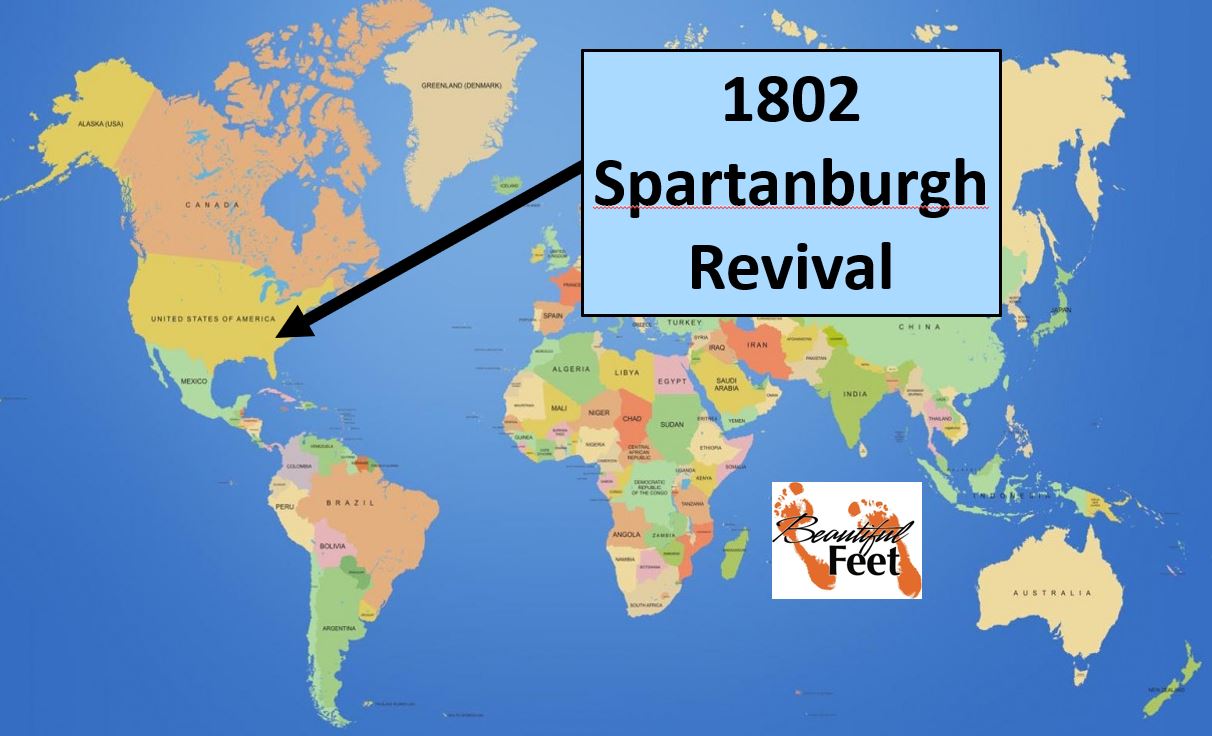
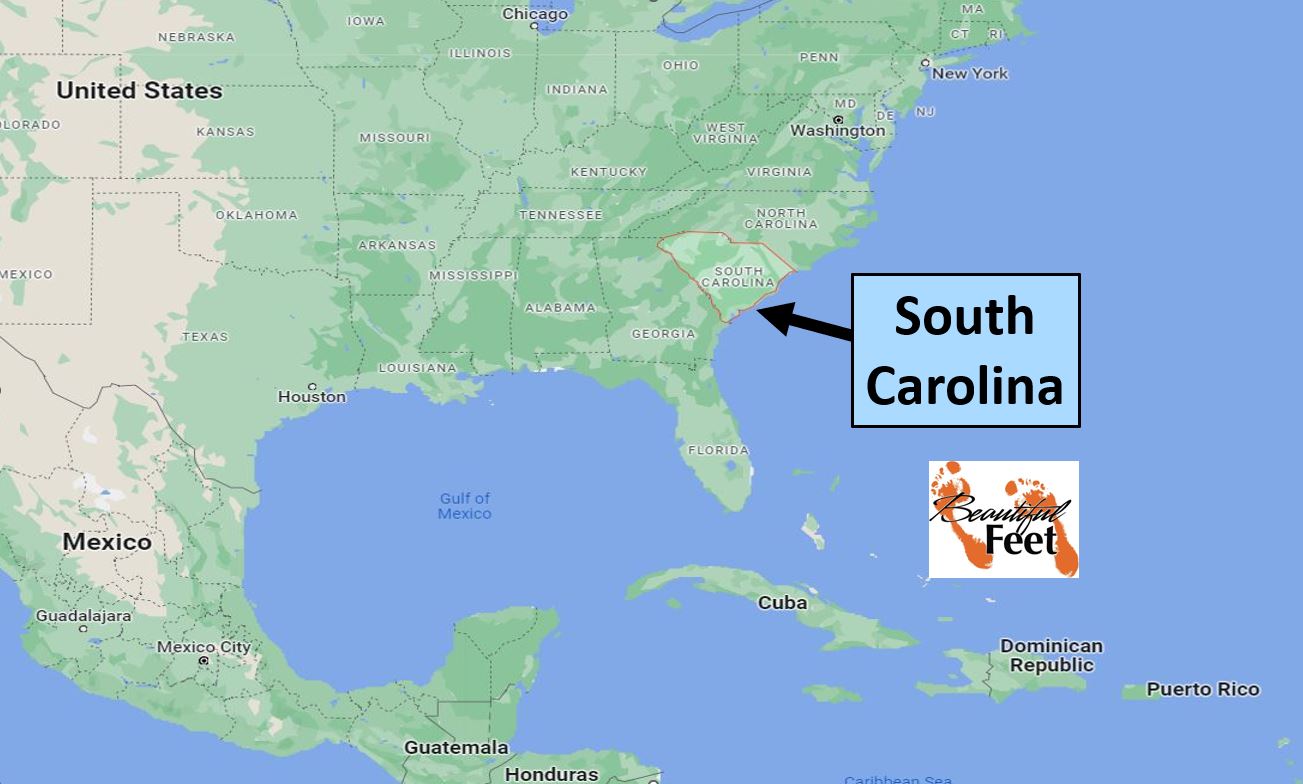
This revival occurred in the vicinity of Spartanburgh, South Carolina. Spartanburgh is now spelled without the letter “h” – Spartanburg.
Background
Occurring at the same time as this revival were revivals just a few miles to the north – 1801-1802 North Carolina Revivals. There were also revivals happening in many different locations throughout the United States at this time, for already underway was the national movement known as the Second Great Awakening.
Here are a few of the revivals that were part of the Second Great Awakening:
► 1790-1840 Second Great Awakening
► 1797 New England Revivals
► 1800s United Brethren Revivals
► 1800 Red River Revival
► 1801 Cane Ridge Revival
► 1801-1802 North Carolina Revivals
► 1802 Yale College Revivals
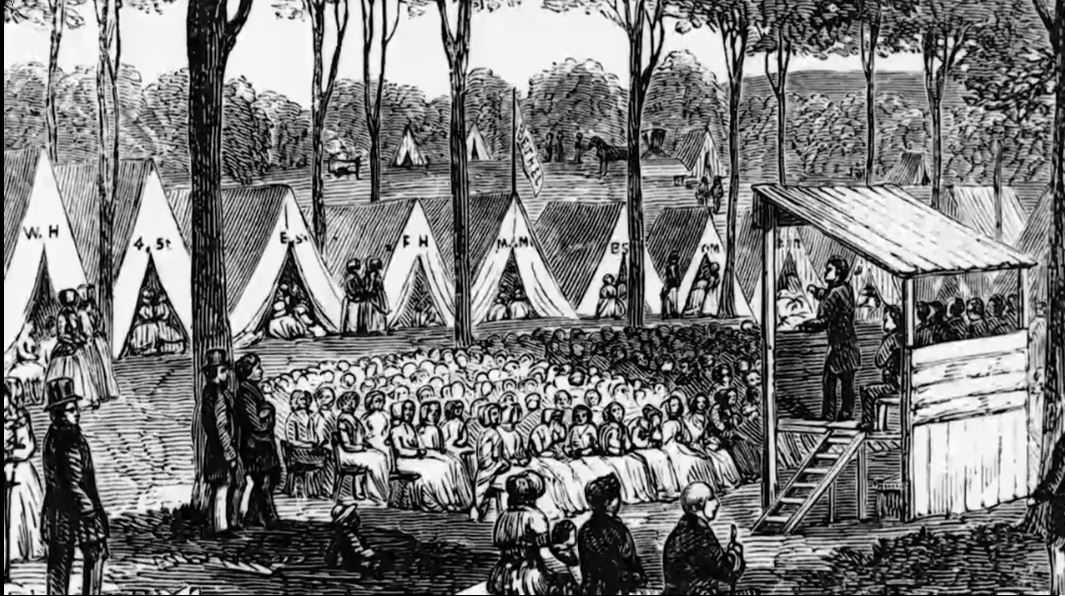
Typical setting of a camp meeting
Introduction to Camp Meetings
Many of the revivals that occurred outside of major cities followed a procedure that was imported from the Presbyterians of Scotland, Ireland, and England, which they referred to as Holy Fairs. Today they would be referred to as Camp Meetings.
The camp meetings were outdoor gatherings, often numbering into the thousands, wherein people would camp from Thursday night till Tuesday of the following week, with communion being offered on Sunday.
Preaching, praying, and singing would fill the schedule, and when crowds were too large for a single preacher’s voice to be heard, separate platforms would be erected, and preaching would then be conducted from different locations simultaneously.
With multiple denominations participating, the Methodist group would preach at one location, the Presbyterian at another, and the Baptist still another, etc.

Crowds would gather like in the above picture and multiple preachers would speak from different locations at the same time.
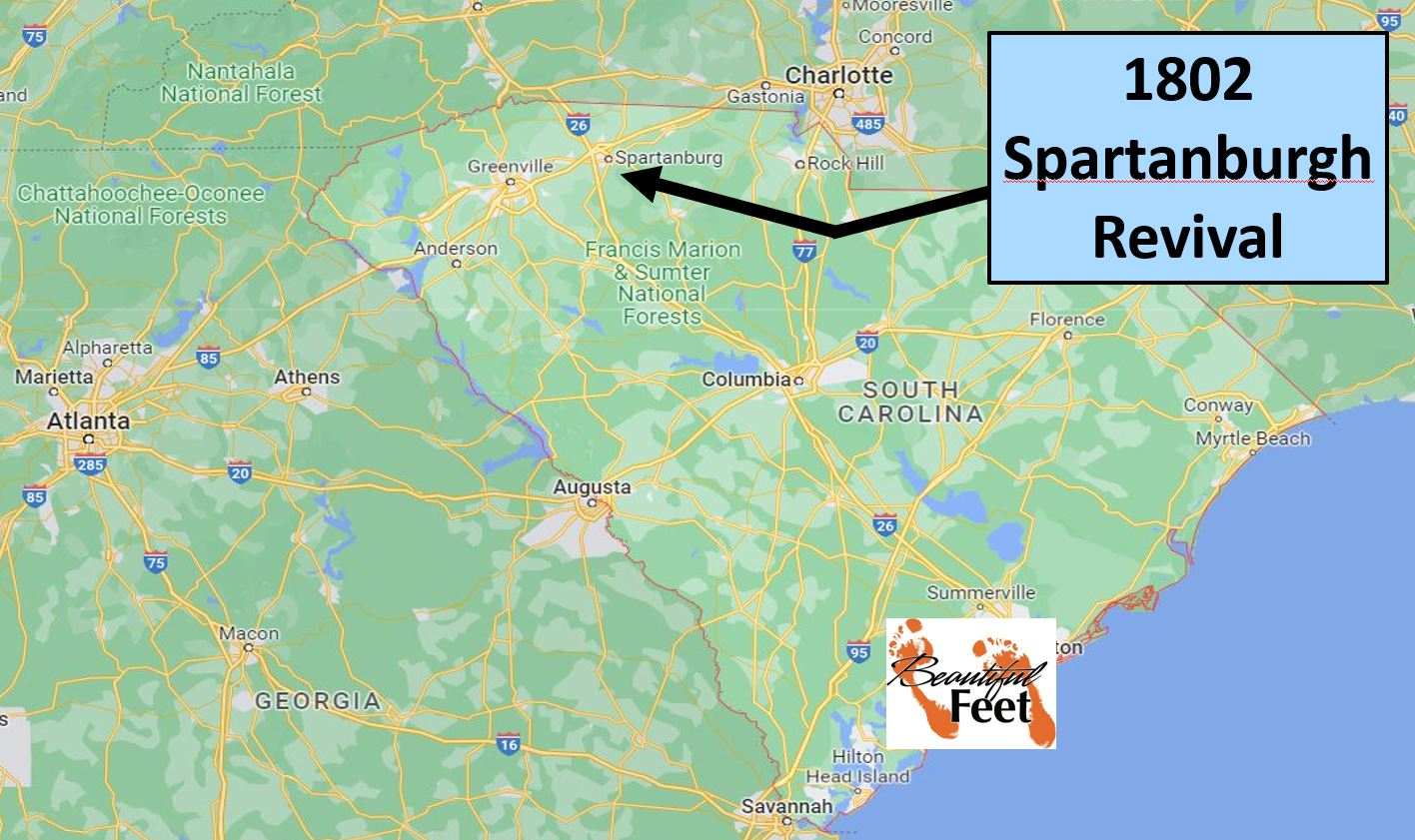
Camp Meeting in the District of Spartanburgh, South Carolina
The Presbyterians scheduled a camp meeting to be held along the Tyger River. It was to begin on a Friday and run till Monday morning. The account of the camp meeting is left to us in a letter written by Ebenezer H. Cummins. In that letter, Cummins wrote that
I have seen and heard things which no tongue can tell, no pen can paint, no language can describe, or of which man can have a just conception, until he has seen, heard and felt.
Acknowledging his “inadequacy to draw a just representation” of what he saw, he left us a small glimpse in the following report.
The Numbers Present
Estimates of people present ranged up to 8,000. Local people said that at least two-thirds of the population of the District of Spartanburgh was present—and Spartanburgh, at that time, had a population of 12,000.
Ministers Present
► 13 Presbyterians
► An unknown number of Methodists and Baptists
Number of Horses and Wagons
► There were about 200 wagons
Day One: Friday
► The services started on Friday at 2pm.
► Two ministers shared about what the camp meetings were for and what should be expected.
► A break was taken.
► Two more sermons were given.
► After dinner, the evening was filled with singing and praying.
► At sundown the people were dismissed to their tents.
Following the dismissal, the people began to experience a seriousness about their spiritual condition. At 10 p.m. two young men were overcome and
. . . were lying speechless, motionless, and sometimes to all appearance, except in the mere act of breathing, dead.
During the night five more were overcome by the same divine power.
The people spent most of the night reading and discussing what they read. There was also singing and exhortations given in small groups.
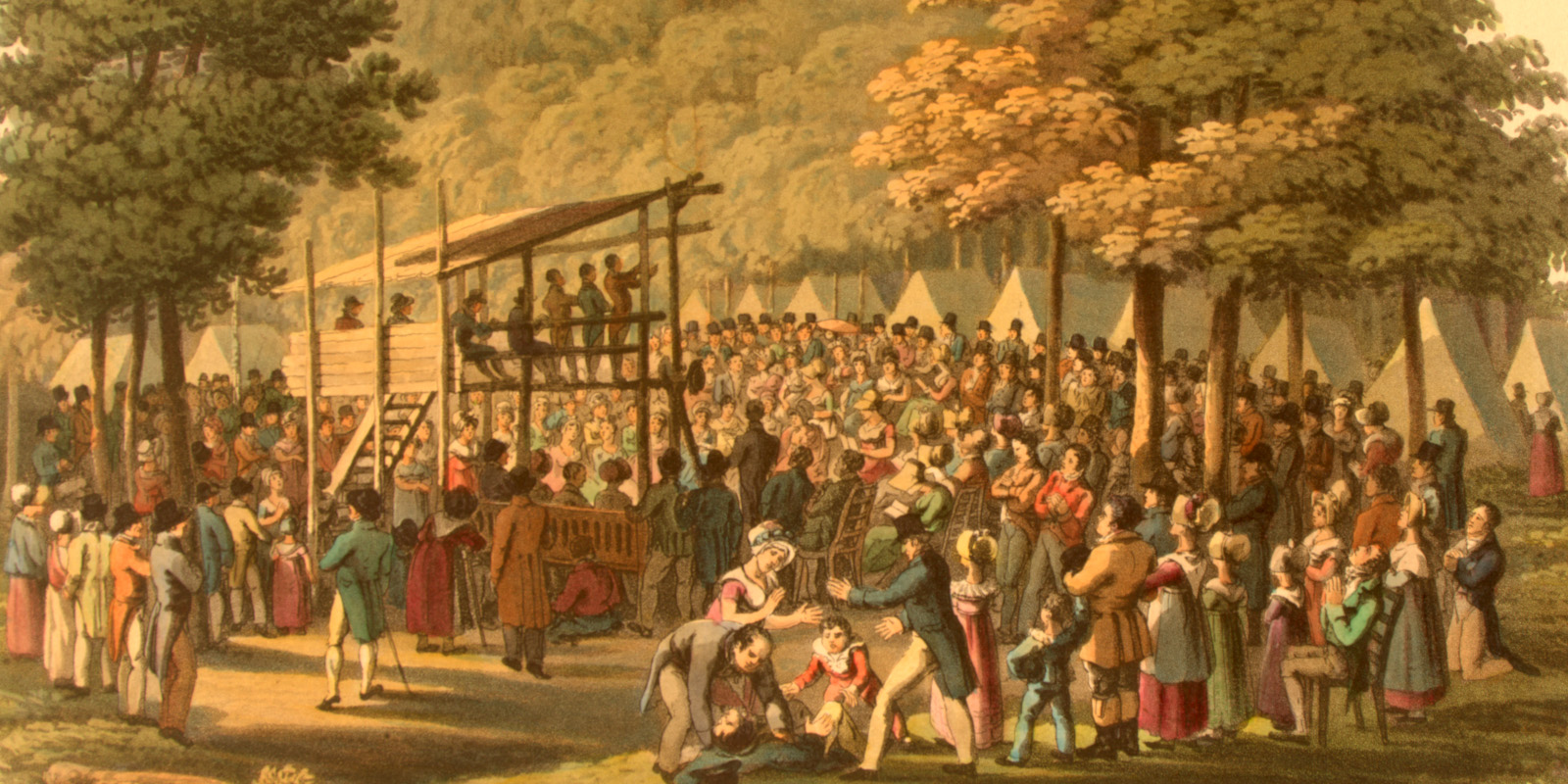
Methodist Camp Meeting from that Era (1819 engraving)
Day Two: Saturday
Beginning at sunrise, the people assembled in their groups and conducted “family worship,” which today we would call devotions.
► The early service began at 8 a.m. with a Methodist minister preaching a sermon.
► Next was a sermon from a Baptist minister.
► Singing, praying, and exhorting continued by the Presbyterian ministers until 2 p.m.
► A break was then taken.
At this time the crowd had grown so large that it wasn’t possible for them to hear the speaker. It was then decided to break the group into two, allowing for two ministers to preach at the same time from different platforms.
► At 2:30 a sermon was delivered, and then followed by yet another.
Following these sermons, there was “fervent praying” which continued into the evening, and that was the time when the presence of God became so powerful that the conviction of sin left many unable to stand, as Cummins writes:
Many were stricken, and numbers brought to the ground.
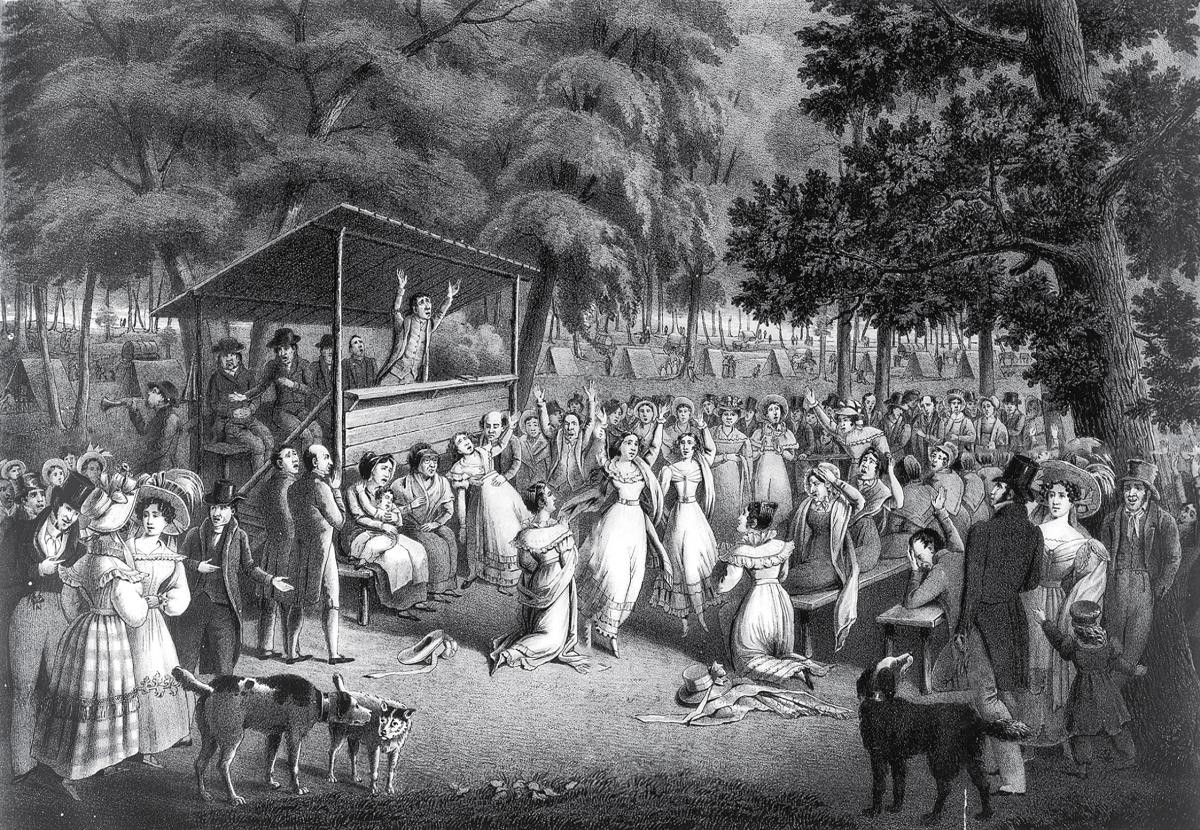
Camp Meeting from that Era (1829)
Day Three: Sunday
► The morning began with several sermons in two separate locations.
► Communion was then offered to about 400 people. Presbyterians conducted a closed communion, which could only be participated in by those previously approved by the ministers.
The services continued in the evening until dark, and it was then that there emerged
. . . one of the most sublime, awfully interesting, and glorious scenes which could possibly be exhibited on this side of eternity.
The scene described by Cummins in his letter was people burdened down with and overcome by severe conviction brought on by the Holy Spirit – leading to cleansing from sin and tremendous rejoicing once sins had been forgiven.
On Sunday evening, from around midnight till 1 a.m., people were spread across the field, and in some locations the ground was almost completely covered with people, crying out to God for salvation.
Day Four: Monday
The people assembled at 7:30 a.m. to participate in the closing service, which involved “singing, exhorting, and a concert of prayer.” Even on this final day, and during the closing service,
Many were stricken, numbers of whom fell [to the ground, overcome by conviction of sin].
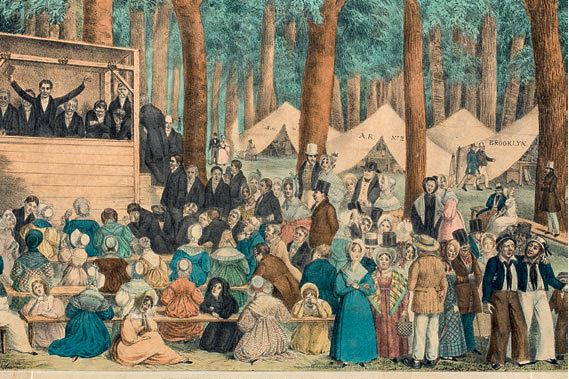
Camp Meeting from that Era (1836)
Effect on the Human Body—Why Such Manifestations?
One of the Presbyterian ministers present, a Mr. Williamson, gave this explanation as to the physical manifestations exhibited by those overcome by the power of God:
These works appear like the last efforts of the Deity to preserve his church, and promote the cause of religion on this earth.
During the same time, with the revivals occurring in North Carolina, another minister, Rev. Samuel M’Corkle, answering the accusations that the camp meetings were out-of-order, and the people’s emotions were allowed to get out of control, replied:
No.—[what was experienced was] An awful sense of the majesty of God— a painful sense of sin—an earnest desire to be delivered from it, &c. &c. Surely there is no disorder here.
In his letter, Ebenezer Cummins attempted to describe how people were moved upon by the Holy Spirit, resulting in the human body exhibiting a physical response.
Cummins said that it was impossible for the people to “feign” what they were experiencing. Here are a few of the descriptions he gives of what he witnessed as people were overcome by the convicting power of the Holy Spirit:
► “Some are wrapped in solitude.”
► “Others cannot refrain from pouring out their whole souls in exhortations to those standing round.”
► People had different stages, “from mild swoons to convulsive spasms.”
► Some “appeared as though their very hearts would burst out of their mouths.”
► “Their lungs are violently agitated and all accompanied with an exhalation.”
► “They feel no bodily pain.”
► “The pulse is quick and regular.”
► “The extremities of the body are sometimes perceptibly cold.”
Source
► A Narrative of a Most Extraordinary Work of Religion in North Carolina by James Hall
► Holy Fairs by Leigh Erich Schmidt
Return to List of Revival Stories
Chet & Phyllis Swearingen:
Office: (260) 920-8248
romans1015@outlook.com
Beautiful Feet
P.O. Box 915
Auburn, IN 46706

